Table of Contents
When you notice pain on the roof of your mouth, it can feel strange and worrying. The roof of your mouth, also called the palate, is made of two parts: the hard palate (the front, bony section) and the soft palate (the back, soft section). Pain in this area can make eating, drinking, and even talking uncomfortable.
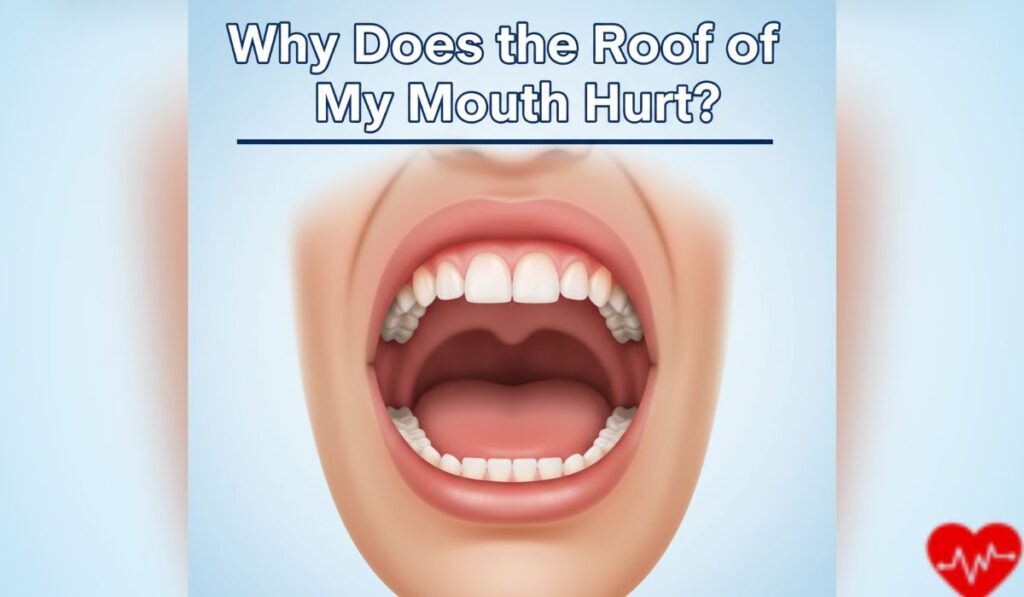
This guide explains why the roof of your mouth may hurt, why your gums and roof of mouth might hurt at the same time, and why your soft palate can hurt when you swallow. You will also learn when to see a dentist or doctor. The goal is to give you trustworthy, easy-to-understand information so you can take the next right step.
Common Reasons for Roof-of-Mouth Pain
Many things can cause this kind of discomfort. Some are mild and heal on their own. Others may need a dentist or doctor’s care.
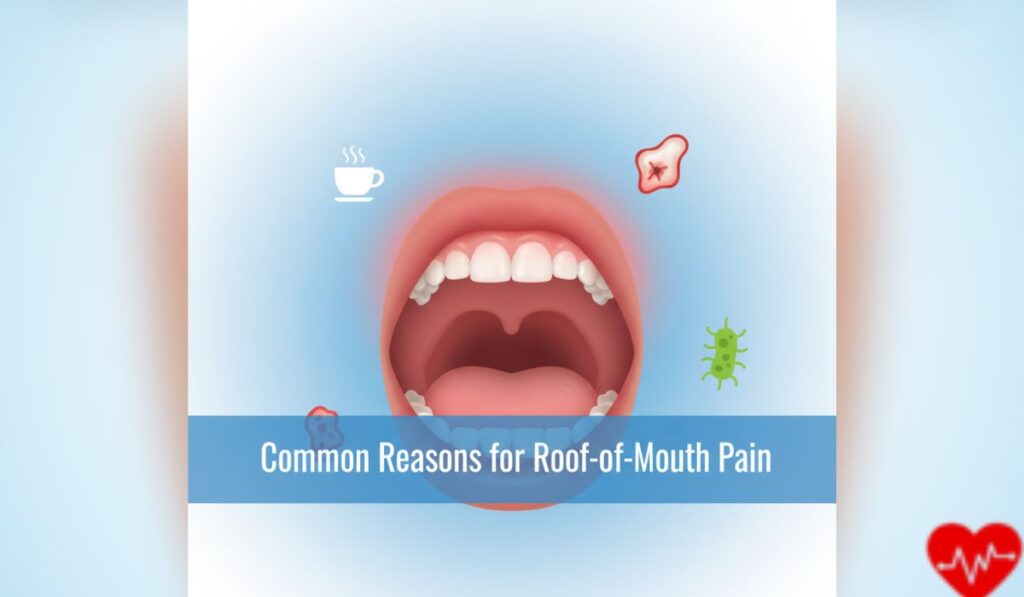
Here are some of the most common causes:
- Burns from Hot Food or Drinks
- Eating pizza that is too hot or drinking boiling tea can burn the delicate skin on the palate.
- A burn usually feels sore for a day or two and may peel like sunburn.
- Canker Sores (Mouth Ulcers)
- Small, round sores that are white or yellow with a red edge.
- They can form on the gums, inside the cheeks, or on the roof of the mouth.
- These are not contagious and usually heal within a week.
- Infections
- Viral infections like a cold or flu can make the roof of your mouth sore.
- Fungal infections (oral thrush) can cause white patches and discomfort.
- Bacterial infections such as strep throat may make swallowing painful.
- Allergies or Irritation
- Allergic reactions to food, pollen, or dust can create swelling and soreness.
- Sharp foods like chips or crusty bread can also scrape the palate.
- Dental Problems
- Gum disease, tooth abscesses, or ill-fitting dentures can cause pain that spreads to the palate.
- Dry Mouth
- Not drinking enough water or breathing through your mouth while sleeping can dry the tissue, making it feel sore or rough.
- Smoking or Alcohol
- Tobacco and heavy alcohol use irritate mouth tissues and slow healing.
- Other Causes
- Sinus infections, vitamin deficiencies (like B12 or iron), or even stress may contribute.
Why Do My Gums and Roof of Mouth Hurt Together?
Sometimes the gums and the palate hurt at the same time. This often happens when the problem affects the whole mouth, not just one spot.
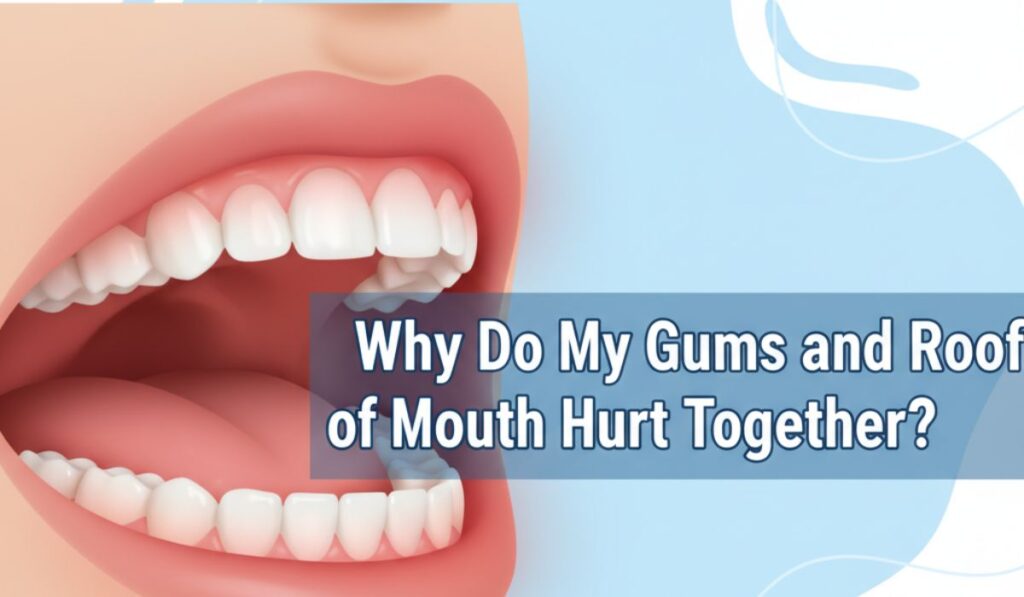
- Gingivitis: Early gum disease causes redness, swelling, and soreness that can spread upward.
- Infections: Thrush or viral infections can inflame both gums and palate.
- Burns or Cuts: Hot or sharp foods can injure both areas in a single bite.
- Allergic Reactions: Food allergies may cause swelling of gums and palate together.
If the pain lasts more than a few days, or you notice bleeding, see a dentist for an exam.
Why Does My Soft Palate Hurt When I Swallow?
The soft palate is the flexible part at the back of the mouth. It moves when you talk, eat, or swallow. Pain here often feels sharper when swallowing.
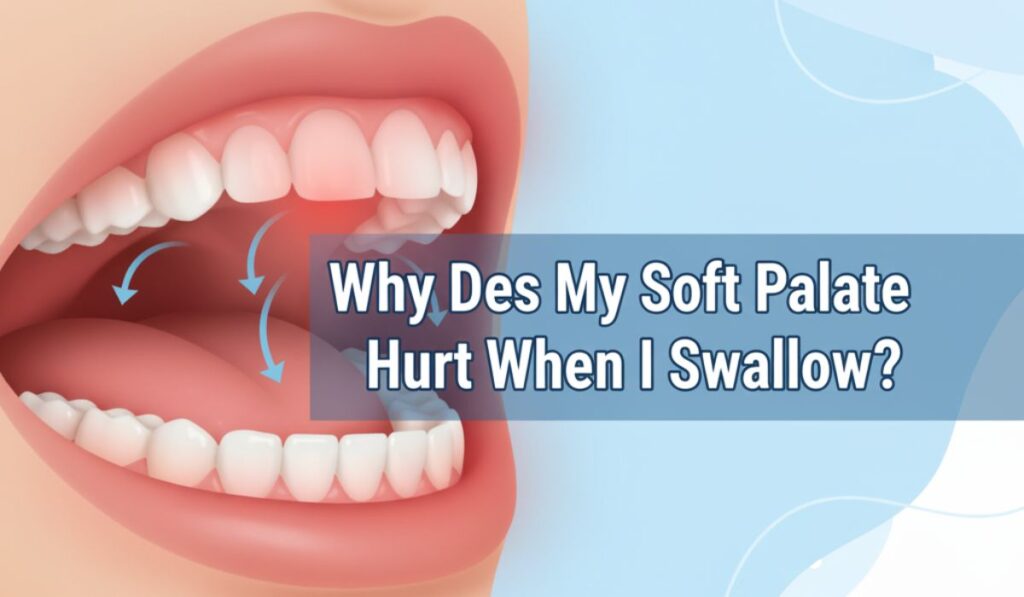
Common reasons include:
- Sore Throat or Tonsillitis: Infection of the throat or tonsils can make the soft palate swollen and painful.
- Postnasal Drip: Mucus from a sinus infection can irritate the soft palate.
- Canker Sores or Ulcers: A single ulcer on the soft palate can hurt more when you swallow.
- Dehydration: Dry tissue is more sensitive and sore.
If you also have a fever, white patches, or severe pain, you should see a healthcare professional.
Self-Care Tips You Can Try at Home
For mild cases, these simple steps can help you feel better:
- Cool Rinse: Swish with cool water or a salt-water rinse (½ teaspoon of salt in a glass of warm water) several times a day.
- Soft Foods: Eat yogurt, smoothies, or soups that are not too hot. Avoid spicy or crunchy foods until it heals.
- Stay Hydrated: Drink plenty of water to keep your mouth moist.
- Over-the-Counter Pain Relief: If needed, mild pain relievers like acetaminophen can help.
- Good Oral Hygiene: Brush gently and floss to prevent infection.
When to See a Dentist or Doctor
Sometimes roof-of-mouth pain is a sign of a bigger problem. Seek professional care if you notice any of these signs:
- Pain lasting more than 7 days without improvement.
- Fever, chills, or swollen lymph nodes.
- White or red patches that don’t go away.
- Difficulty swallowing or breathing.
- Bleeding that doesn’t stop.
A dentist or doctor can examine your mouth, run tests if needed, and provide treatment such as prescription medicine.
How to Prevent Roof-of-Mouth Pain
Prevention is always better than cure. Here are simple habits that protect your mouth:
- Check Food Temperature: Let hot drinks and food cool slightly before eating.
- Stay Hydrated: Drink plenty of water, especially in hot weather or when you’re active.
- Good Oral Care: Brush twice a day with fluoride toothpaste and floss daily.
- Healthy Diet: Eat plenty of fruits, vegetables, and foods rich in vitamins B and C.
- Quit Smoking: Tobacco damages mouth tissue and slows healing.
- Manage Allergies: Treat allergies early to avoid irritation.
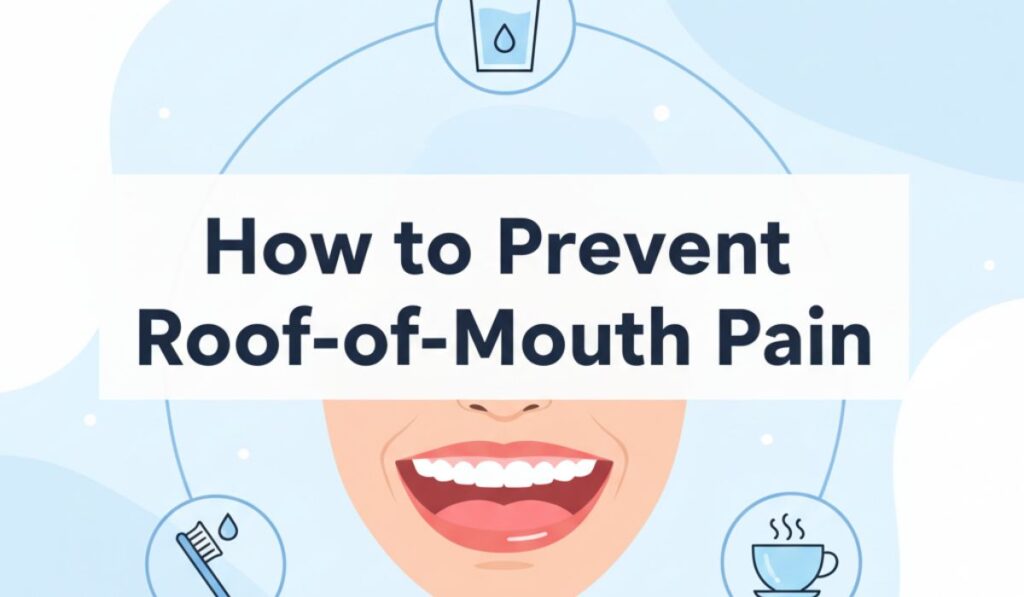
Key Takeaways
- Pain in the roof of the mouth is common and usually not serious.
- Burns, canker sores, infections, and allergies are the top causes.
- If both gums and palate hurt, check for gum disease or infection.
- Soft palate pain while swallowing often points to throat infection or irritation.
- Most cases heal in a few days with good care and hydration.
- Seek professional help if symptoms last longer than a week or come with fever, severe pain, or trouble swallowing.
Final Word
Your mouth is an important part of your health. While mild soreness often improves on its own, persistent or severe pain needs attention. If you are unsure, it’s always safest to see a dentist or doctor. They can find the real cause and help you heal faster.


